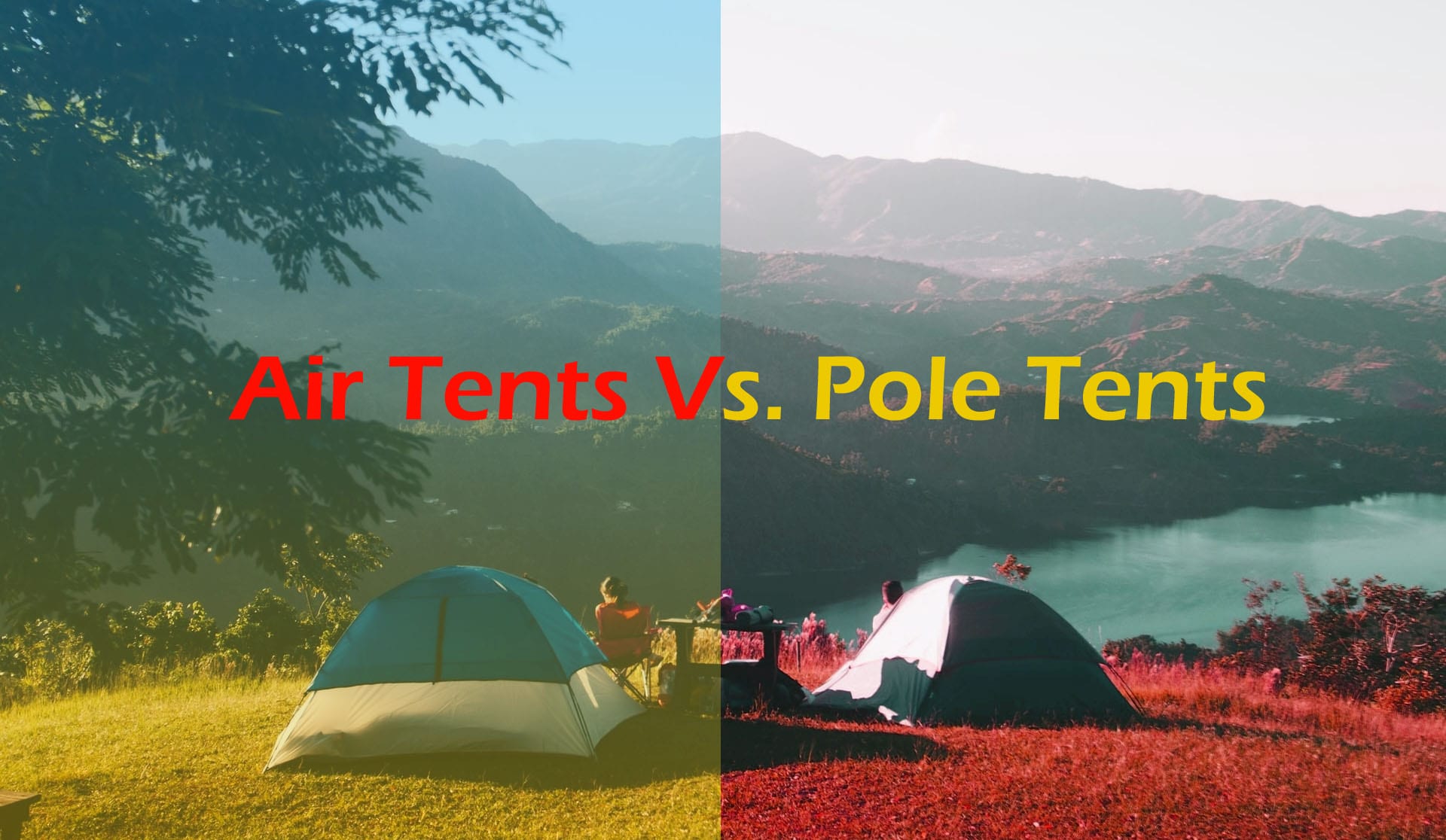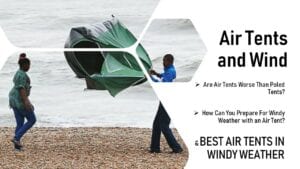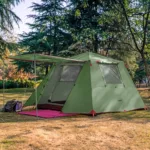The market for air tents (or inflatable tents) has been growing for years. It seems there’s still a slight hesitance when it comes to buying a new tent: which one is better, air tent or a normal pole tent? The air tents vs pole tents debate seems a bit endless and it does not look that there’s an easy answer. Not yet.
While each has its strengths and weaknesses, it seems to me that this dilemma stems from the lack of trust towards early airbeam tents.
Air tents have evolved so much in the last few years that I feel, this question needs new answers, updated answers. And don’t forget, while plenty of research and development has gone into air tents, traditional pole tents have evolved too. And then there’s the difference in price. Which one is actually better value for money? Should you pay double the price just for the comfort of easier and 5-10-minute faster pitching?
In this post I have looked at a few points, but you’ll be the judge.
In my opinion, air tents are slightly in favour in this comparison, but it depends on the size of the tent you are after, and your budget. Air tents are the future of large family tents, that seems evident; while pole tents will remain dominant in the 4-berth and less segment.

Air tents vs Poles tents
Table of contents
Stability of air tents vs pole tents
I think a common misconception is that air tents are less stable than pole tents. I can totally understand: the first image comes to mind when I hear ‘inflatable’ is a bouncy castle being deflated, and for some reason I always feel sad when I see a bouncy castle being slowly released of air. Great fun though.
But the thing is, people often forget about the fibreglass poles that can snap, and they do snap. And when they snap they can even punch through the flysheet, rendering the whole tent useless.
When an airbeam fails, worst case scenario you won’t be able to erect it. They don’t snap. More often than not, you’d have beam repair kit in you bag, and you can put a patch on that hole in no time. If they rip along the welding, or the valve decides to retire, well, that sucks, but you can always buy replacement tubes.
The material of the tube itself is very sturdy though, you won’t be able punch it accidentally.
While you can buy replacement poles for your pole tent, some models simply lack the replacement poles. Before you buy a pole tent, I’d suggest you ALWAYS search for any available replacement poles, and order them straight after you buy the pole tent. And watch ‘How to repair you tent poles’ videos on Youtube.

A collapsed pole tent – despite the myth that air tents are susceptible to collapsing, it is actually pole tents that cannot flex out windload
Are air tents good in wind?
As for stability when everything is right: the airbeams will always have the advantage of being more flexible. Under considerable load – in high winds for example – airbeam will perform better. Most air tents are stable enough to withstand gale force winds, as long as they are pitched correctly.
Related post: Best Air Tents in Wind
This may be true for traditional poled tents too, but there’s always the risk of the poles proving to be too rigid, and ultimately, buckle or snap under windload. A pole tent may be more rigid at the time, but should the wind get too strong where an air tent will flex and take the pressure even if flattened to the floor, solid poles will bend and break, potentially ripping tent fabric and causing a lot of damage.
Can you overinflate air tubes?
No you can’t. The normal pressure is always set with a comfortable play in both directions, and air tubes are tested to the extremes. Outwell for example tests their air poles to 24psi, while they can only physically be inflated to around 11psi.
Actually, air tent manufacturers advice you to slightly increase the pressure when you need to increase the stability of the tent, ie. when you are bracing yourself for an Amber weather warning on a clifftop campsite.
On top of this, you can’t really inflate a beam designed for 8 psi, to 15 psi for example. The reason for this is the valve: most valves would have a pin that elevates as the pressure increases inside the air tube. Once you reach the required pressure, they would simply close and would not let any more air in.
There is always the possibility to buy an electric pump on which you can set the pressure to the manufacturer’s recommendation. You press the button and watch the airbeam inflate exactly to the settings.
Pitching
One of the biggest advantage of air tents is faster pitching. However, the advantage of faster pitching is often exaggerated to push people towards air tents – after all, this is one the main selling points of air beam tents vs. normal tents. But if you think about how many phases of pitching a tent there are, the actual task of inflating vs. putting the poles into the sleeve does not count to more than 25% of the time.

It does not actually take 3 people to pitch a pole tent. Source
Any savings made in that phase of course will count towards the total time, but overall, the time saving will be limited. The time it takes to roll out the footprint and the groundsheet, to stake them out is virtually the same for air tents and pole tents alike. When erected, there’s still guylines to be pegged out – again, same number on both tents. Not to mention, the fiddling with poles vs. fiddling with the pump and finding the valve etc.
Are air beam tents easier to pitch?
Yes, slightly faster and easier: where a 6-person poled tent needs 20 minutes for pitching, you may be able to set up the 6-berth airbeam tent in 15 minutes or so, with some practice.
If you are worried about looking inexperienced when trying to find the correct poles, rest assured, most pole tents have colour-coded poles now, it can’t really be any easier to find the correct poles for the correct sleeves.
On some smaller tents, the time saving is actually so minimal – a couple of minutes at best – that it’s pointless to buy the airbeam version just because ‘it is faster to pitch’.
The Vango Keswick Air for example claims a 12-minute pitching time (realistically around 15 minutes), the poled Keswick claims a 22-minute pitching time. This is close to being realistic, however, this guy in this video pitched AND packed away the Vango Aether 600XL (similar size to the Keswick 600DLX) in 24 minutes all by himself – while the ‘official’ pitching time for the Vango Aether 600XL is 25 minutes.
Packing away
Any advantage the airbeams had at pitching, can quickly disappear when the time comes to deflate them.
While fibreglass poles will pack away as fast as they have come out, if not faster; air beams will be a constant struggle to deflate AND to remove any residual air from them. That’s why rolling an air tent up is always a bit more difficult, and it takes practice and practice and practice until it becomes a smooth, stress-free process.
Weight
Air tents appear to be heavier than pole tents. It’s worth bearing that in mind, when you think about how you are going to get around the campsite, how often and how far you’ll move the tent, how and where in the car the tent will go.
For example, the Vango Keswick II Air 600DLX is a large, 6-person airbeam tent. It weighs 33.6 kgs, including the pump, and the size of the carrybag is 75 x 43 x 53 cm. Large, bulky, you can’t really put it in the roofbox (too big, too heavy to lift above head-height)
Its identical sibling with traditional poles, the Vango Keswick II 600DLX weighs only 24.6 kgs, the size of the carrybag is 70 x 37 x 36 cms. It is still heavy, but almost 2/3 of the weight of the airbeam model. The size of the carrybag is much smaller, you can actually think about fitting it into a 350L roofbox.
Space and size
There is not much difference between the size on offer, external or internal. The examples in the above section are virtually the same size, other than the size of the carrybag. What gives a slight advantage to air tents versus pole tents is the maximum size that you can reach: the biggest pole tents seems to be no more than 8-berth, while you can find inflatable and hybrid tents up to 12 berths.
On the other hand, there is a somewhat limited selection of smaller air tents. You won’t really find any air tents under 3-berth, and generally speaking there’s wider selection of 3-person pole tents than 3-person air tents.

Availability
I’ve touched on it above – depending on the size of the tent you are after, you’ll find a mostly uneven range of tents.
Under 4 berths, normal poled tents seem to be the majority. The market is even for 4-6-berth tents, with air tents coming up. Above 6-berth, there is a wider selection of air tents.
This was not true a few years ago, when availability of air tents, or the lack thereof, was an issue. If you wanted to buy a reasonably sized family tent, you probably ended up with 6-berth pole tent simply because the air tents available at the time were to few, out of stock, not quite right or simply just too expensive, in addition to the concerns around reliability and stability.
As you could see in this post, none of these is a concern anymore, apart from, maybe, the price.
The real limiting factor here is stock levels: there seems to be a huge demand for the entry level budget air tents, so they run out of stock quickly.
Price
Simply put, air tents are more expensive. If we simplified this air tent vs pole tent debate purely to their retail price, pole tents would be the clear winners. But the thing is: air technology is quite new, and the price gap seems to be closing.
There are air tents that cannot exist as poled tents, due to the additional stability and flexibility the air beams provide. So the higher price of these air tents are justified.
The air tent vs pole tent debate takes an interesting turn when you start comparing like for like tents.
Using the examples above, and few more:
Air Tent – Price | Price – Pole Tent
Vango Keswick II Air 600DLX – £999 | £450 – Vango Keswick II 600 DLX Pole
Vango Aether 450 Air – £595 | £430 –Vango Aether 450 Pole
Kampa Hayling 6 Air – £775 | £445 – Kampa Hayling 6 Pole
Kampa Brean 4 Air – £465 | £290 – Kampa Brean 4 Pole
Eurohike Genus 400 – £219 | £169 – Vango Carron 400 Pole
Eurohike Genus 800 Air – £299 | £349 – Vango Longleat II 800XL
Is the 45-75% higher price of the air tents justified? Well, yes and no. I believe prices will come further down eventually, but for now, if you are looking for a decent 6-berth family tent, you’ll be way better off with a pole tent. Strictly speaking. If your budget is limited, say £500, my advise would be to get a poled tent.
If your budget has some flexibility, I believe that in the long run, when you take into account the increased stability, especially in foul weather; and the less risk that comes with an air tent, it might be a hesitant yes for pole tents but I’d actually lean towards an air tent.
On the other hand, there are quite a few entry level air tents (Eurohike for example) that are actually cheaper than a similar-size pole tent. No wonder they are popular and often out of stock!
Verdict
As you could see, there is not a straight answer. There are entry-level air tents that are cheaper than poled tents of the same size. There are air tents that cost almost double the price of the same tent with fibreglass poles.
The actual benefit you get with an air tent, faster pitching time, is at best marginal – and I have a feeling that manufacturers are trying to push people towards the more expensive air tents by understating the actual pitching time, while overstating the pitching time of their fibreglass pole counterparts.
There is some additional benefit of air beams like increased stability in severe weather, but at a cost of bigger and heavier carrybags.
My verdict?
There isn’t one. Depending on the actual size of the tent you’re after and the difference in price between air beams vs poles, the outcome can vary. I’d lightly pick the poled Vango Keswick II 600DLX versus the air beam Keswick for example. But I would be in trouble if I had to pick between the Vango Joro 600XL Air (£759) and its poled counterpart! (£525)
It seems to me that – apart from a few obvious examples where an air tent is simply cheaper than a pole tent of the same size – buying an air tent is an emotional decision, rather than a practical / sensible one.



Probably the best, most logical comparison I’ve read. Ticks every box for every question you could ask. And the conclusion: spot on!